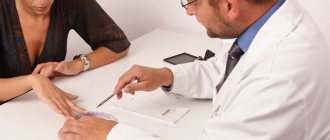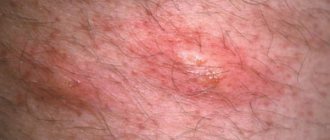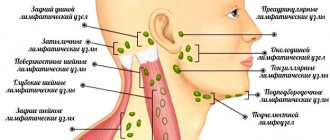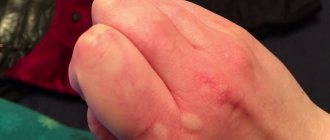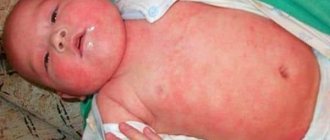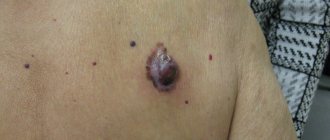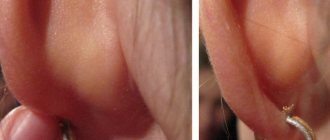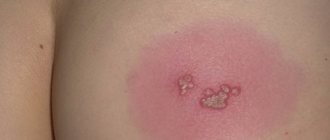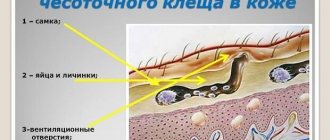When a fungus appears in the ears, you need to immediately begin to fight it using suitable medications in the form of ointments, drops or tablets. According to WHO, in our country, every fifth person is a carrier of a fungus that can develop in the ears. In general, this pathology is called otomycosis, and a fungal infection can develop on the mucous membranes or skin of the ears.
The most effective medicines for fungus in the ears in humans are considered to be topical preparations in the form of ointments and drops, and tablets are mainly used as auxiliary medications.
- Preparation before using topical treatments for fungus
- What antifungal drops does the doctor prescribe?
- Ointments for ear fungus
- What auxiliary drugs are needed?
- Folk remedies for ear fungus
Causes of the disease
Fungus in the ears is a consequence of the penetration of pathogenic microflora into the ears. It can be caused by both internal and external reasons.
Internal factors are taken into account if the pathology is provoked by part of the normal human microflora - a yeast-like fungus of the genus Candida. Possible reasons include:
- violation of ear hygiene;
- inflammation of the middle ear;
- damage to the ears and ear canal;
- weakening of the immune system.
Any crack or microdamage to the auricle and ear canal are favorable conditions for infection. Most often, fungal diseases are provoked by those fungi that are already present in the human body, for example, the genus Candida. Ear fungus can occur due to lack of proper ear care. Also, fungus in the ears is a consequence of excessive hygiene and the use of cotton swabs.
Using a cotton swab too hard can lead to problems
Another reason for the development of the disease is water getting into the ear canal. Sometimes when diving, water gets into the ears and remains there for several days. Increased humidity and body temperature create an ideal environment for the proliferation of pathogenic microflora, and fungus appears in the ears.
The disease is often diagnosed after episodes of severely decreased immunity. This is observed after recent infectious diseases, long-term antibiotic therapy, as a result of stress and taking hormonal drugs.
In addition, ear fungus can be acquired through contact with infected people. External causes of the disease include:
- using someone else's headphones;
- trying on other people's hats;
- use of towels and other bath accessories;
- diving in a public pool.
The most common route of infection is the use of someone else's headphones. This is how the fungus quickly enters the ear canal. Fungal spores can remain on the hair and get on the skin around the ears, so the disease can be acquired by trying on other people's hats.
The main feature of fungus in the human ears is its rapid progression, so treatment must be started immediately.
The best ointments against ear fungus
Fungus is a fairly common pathology that many are familiar with firsthand. Most often, the fungus affects the nail plates and skin. In more rare cases, the disease can affect the ear cavity. This disease is called “otomycosis”.
According to statistics, every fifth person is at risk of developing otomycosis because they are carriers of pathogenic fungi.
Treatment should be prescribed by a doctor only after a thorough examination and the necessary diagnostic procedures. Drugs are selected individually.
In most cases, the specialist prescribes topical anti-fungal ointments. As an additional point of therapy, tablets and drops can be prescribed.
Causes of ear fungus
Today, experts have identified several possible factors that can trigger the development of otomycosis in the ears. These include:
- infectious and inflammatory ear diseases;
- trauma/mechanical damage to the auditory organs;
- long-term use of antibacterial or hormonal drugs;
- presence of fluid in the ear cavity;
- narrowness of the ear canal;
- intensive cleansing of the ear canal from wax;
- using personal hygiene products that are not your own;
- weakened immunity.
Excessive weakening of the immune system is possible due to recent illnesses. Also, the resistance of the body to various infections can be affected by nervous tension, stress, and overwork. Irrational use of antibacterial and hormonal drugs negatively affects the immune system, depleting it, giving the “green light” for the proliferation of fungus.
It is worth noting that often a fungal infection develops due to damage to the integrity of the tissues of the ear canals. In the absence of timely therapeutic treatment, the fungus will begin to actively spread to the middle ear cavity.
Diseases of the auditory organs of a purulent nature are the next equally common cause of otomycosis. The purulent masses located inside the ear cavity become an ideal environment for the proliferation of pathogenic microorganisms.
Associated symptoms
The symptoms of fungal infection of the ears are quite varied. Let's consider the most pronounced signs that will help the patient recognize the cause of his constant discomfort:
- unpleasant unbearable itching inside the ear cavity. If the tissues are damaged during intense scratching, the fungus will begin to actively spread to the affected areas;
- discharge from the ear, the color of which can vary from pale yellow to green. Some patients may experience black discharge;
- intense peeling of the skin around and inside the ear canal;
- decreased sensitivity of affected areas;
- feeling of ear congestion, decreased sound perception, constant noise;
- pain inside the ear cavity, sometimes radiating to the head area;
- excessive formation of earwax, which leads to the appearance of plugs.
If a person does not begin to take the necessary measures in time, there is a risk of developing such negative consequences as:
- suppuration;
- sepsis;
- fungal infections can spread deep into the ear cavity;
- persistent deterioration of hearing, which entails complete loss.
Types of fungus
Depending on what type of fungus affected the ear, characteristic symptoms will be observed. For the most part, fungal infection settles on mucous tissues and skin. Let's look at the main types of fungi that most often affect the ear cavity:
- The yeast fungus of the Candida family is a provocateur of otomycosis in 25% of the disease. As a rule, it spreads along the inner surface of the auditory cavity, further affecting the middle ear. In some cases, it can appear in the area behind the ears. Externally it resembles eczema. A distinctive feature of this type is a cheesy discharge. Itching is present throughout the entire duration of the disease;
- Aspergillus is an aerobic mold. According to statistics, most of this pathology occurs due to the proliferation of this particular type of fungus. It spreads in the area of the auricle, as well as inside it. There have been cases of penetration deep into the auditory canal. In terms of external indicators, it resembles plaque, its structure is similar to dandruff, which is located around the ear;
- Other pathogenic microorganisms of a special type. In other cases, the skin is affected. They are provocateurs of the development of blastomycosis (a fungal infection that can affect internal organs) and coccidiosis (an infectious disease that mainly affects birds and rodents). The symptoms are pronounced.
Treatment of fungus with ointments
In order for therapy to have the most effective result, a specialist must determine the cause of this pathology. If the patient was taking antibacterial drugs, then most likely, treatment will begin with the abolition of antibiotic therapy. In the future, the necessary measures are taken to increase local immunity. A course of vitamin complex is prescribed.
The affected ear is systematically treated with a glycerin solution. This is necessary so that the prescribed ointment or drops have the most effective result. This procedure also allows the drug to penetrate as far as possible.
This is important: To treat fungal infections, the doctor prescribes local therapy. If the process begins to be aggravated by various complications, the specialist decides on the use of treatment at a general level.
According to many experts, the best therapeutic effect can be achieved using drugs in the form of ointments. You can buy these medicines at any pharmacy.
Before applying the ointment prescribed by the doctor, the surface of the affected area is thoroughly cleaned. It is best to clean the surface using oil solutions such as glycerin. Because water is an ideal environment for fungal growth.
Ointments that will help cope with this disease:
- Mycosporus;
- Travogen;
- Itraconazole;
- Nitrofungin;
- Naftifin;
- Amphotericin;
- Pevaril;
- Terbinafine;
- Decamine ointment.
Mycospor
The main active ingredient is bifonazole. The peculiarity of the drug is its rapid absorption, without penetrating into the blood.
A small amount of ointment is applied to the affected area; for the best effect, you can fix the treated surface with a bandage and leave it overnight. The duration will depend on the extent of the damage.
On average, therapy lasts from 3 to 8 weeks with ointment applied 2-3 times a day. In more advanced cases, therapy can last up to 18 weeks.
Contraindications for use are hypersensitivity to the components of the drug, pregnant women, children. Side effects:
- soreness;
- swelling;
- hives;
- dryness;
- burning.
Travogen
The main active ingredient is isoconazole nitrate. The drug has an effective antibacterial effect. According to many buyers, this ointment is fast-acting and safe. Easily penetrates, destroying the membranes of pathogenic microorganisms.
Apply a thin layer to the affected area and adjacent tissues 1-2 times a day. Contraindications include sensitivity to the active components. Use with caution in children and pregnant women.
Itraconazole
A drug that has a broad spectrum antifungal effect. It suppresses synthesis on the membranes of pathogenic cells, and also prevents further proliferation of fungal microflora.
Not recommended for onychomycosis. Contraindications include individual intolerance to the components of the drug, pregnancy, childhood and adolescence under 16 years of age. Possible side effects: unpleasant burning sensation and itching.
Nitrofungin
Antifungal drug for external use. It is mainly available in the form of a solution, but there are ointments that have the same characteristics.
The application procedure is as follows: the solution is applied to a cotton pad, then placed in the cleaned ear canal. The number of procedures performed per day is 3 times. The duration of treatment is 1 month. These indicators may be varied by the attending physician.
Contraindications include:
- children under 2 years of age;
- individual intolerance to components;
- pregnancy and lactation period.
Naftifin
An antifungal drug whose main action is aimed at blocking enzymes. As a result of the action of the drug, a change in the structure of pathogenic cells occurs. Contraindications include:
- mechanical damage to the skin (open wounds);
- individual intolerance to the main components;
- pregnancy and lactation period.
Amphotericin
Antifungal agent for external and local use. Refers to a type of polyene macrocyclic antibiotics. Apply a thin layer 2 to 4 times a day for 1-3 weeks. The course of treatment can be changed according to the action and course of the disease.
Contraindications include hypersensitivity. Side effects: burning, tingling sensation, dryness and hyperemia of the skin.
Pevaril
An antifungal drug with the active substance is econazole. The product has a fungicidal and bactericidal effect. In the process of local use, the death of the fungus is possible already on the 3rd day. Apply a thin layer 2 times a day.
Contraindications for use: hypersensitivity, use with caution and only on doctor's recommendations during pregnancy and lactation.
Terbinafine
An antifungal drug that is active against most fungi. Can be used for preventive purposes.
Contraindications include: hypersensitivity to the components of the drug, use with caution during pregnancy/lactation, as well as children under 12 years of age.
Decamine ointment
An effective antifungal drug that contains dequalinium chloride. The main properties of the ointment include: antibacterial action and antifungal effect.
A local allergic reaction may occur in the form of irritation, peeling, and hyperemia. If you are pregnant, you should consult your doctor.
Folk remedies
Along with the use of ointments, you can use traditional medicine recipes:
- Celandine decoction - the decoction is instilled onto a cotton swab (5 drops), and then injected into the sore ear;
- It is recommended to treat the affected area with apple cider vinegar.
Complications
Complications of otomycosis:
- chronic course of the disease;
- bacterial infection;
- development of eczema of the outer ear;
- secondary foci of infection.
Prevention
Prevention of the disease is as follows:
- using only your own hygiene products;
- neat and gentle ear cleaning;
- strengthening the immune system.
Ear ointment for fungus should be prescribed by a specialist after a thorough examination and a series of diagnostic procedures. Take your health more seriously, follow all doctor's orders.
Source: https://StopOtit.ru/effektivnie-mazi-protiv-gribka-ushej.html
Types of otomycosis
Fungus in the ears is classified according to the type of causative agent of the inflammatory process.
The most common forms of the disease are infection with mold and yeast-like fungi. Molds develop when immunity is greatly reduced. This form of the disease is most often encountered by patients with diabetes mellitus and patients with HIV.
Anyone can become infected with yeast. Some types of this microflora are always present in the human body and are activated when the body is weakened. Yeast can get into the ears with athlete's foot and fungal seborrheic dermatitis. In this case, fungi of the genus Candida or Malasesia fungus are found in the scraping.
The most severe form of the disease is infection with pathogenic fungi. Infection can occur in various ways. The fungus can get into the ear by using another infected person's clothing or headphones. Some types of pathogenic fungi are found in the soil, so touching your ears with dirty hands can cause infection. Pathogenic fungi also include species that cause lichen in animals. Contact with street animals can cause infection.
It is important to understand that fungal spores are carried through the air and can remain on clothing or interior items for a long time. The disease does not always develop due to contact with infected people or animals. In some cases, a person may not even know where the fungal infection came from.
Based on the intensity of the pathological process, external and internal lesions are distinguished. In the first case, a fungal infection develops in the auricle, in the second case it affects the ear canal and middle ear. The external form of the fungal disease progresses quite quickly, fungal spores penetrate the ear canal and eventually reach the middle ear.
The deeper the fungus penetrates, the more serious the situation
Review: Candibiotic ear drops Glenmark Pharmaceuticals. How I got rid of otomycosis of the ear
Galina, Irkutsk06/28/2019
Advantage: The drug copes well with ear fungus
Disadvantages: Not noted
Five months ago I was diagnosed with otomycosis of the ear. It seemed to me that it was a cold, because in addition to the pain in the ear there were also catarrhal symptoms. The pain was tolerable, but the blocked ear could not hear anything. Before going to the doctor, I self-medicated, which did not help.
The doctor clarified the diagnosis, washed the ear canal and prescribed candibiotic drops with nitrofungin.
The candibiotic, as described, consists of clotrimazole (an antifungal agent) and chloramphenicol (a broad-spectrum antibiotic).
Indications:
- otitis of the external ear, acute or diffuse
- acute form of otitis media
- chronic stage of otitis with exacerbation
- condition after ear surgery.
It seemed that otomycosis of the ear had something to do with it, about which nothing was said in the annotation. However, it’s all about the active component of the drug, which plays a significant role in the treatment of ear fungus.
Treatment course is five days
Day 1
In the morning I dripped hydrogen peroxide into my ear, wait until it hisses, then I drop candibiotic
In the evening I drip candibiotic and nitrofungin
The second and subsequent days are the same, but without the use of hydrogen peroxide.
Candibiotic is an oily, fatty mass. The drug does not have a warming effect and does not cause tickling or itching. Unfortunately, even though I lay on the couch for several minutes, the liquid still flowed out of my ear, contaminating my hair. But it doesn't matter.
Candibiotic has a pipette that accurately dispenses the number of drops. I can make everyone happy. On the 3rd day, my ear began to hear and the congestion disappeared. In my opinion, initial ear treatment by an ENT doctor played an important role in removing the fungus.
After a five-day course of treatment, I came for an examination. The doctor stated a complete cure of otomycosis of the ear. But for prevention, he recommended taking the drugs for another three days.
If you have been diagnosed with otomycosis of the ear, undergo the same course of treatment in consultation with your doctor. Be healthy!
Symptoms of the disease
With ear fungus, symptoms depend on the depth of the infection. At the beginning of the pathological process in the auricle, ear fungus in people has the following symptoms:
- itching of the ears;
- formation of dense yellow crusts;
- peeling of the skin;
- small rash;
- separation of large scales.
These symptoms are in many ways similar to seborrheic dermatitis, since damage to the ears can be a consequence of the spread of a fungal infection of the scalp. This form of the disease is harmless and can be quickly treated with drops and special antifungal solutions. The danger is that the disease progresses very quickly. Fungal spores enter the ear canal. A closed humid environment and the temperature of the human body create favorable conditions for the rapid growth of the population of pathogenic microflora. After a short period of time, symptoms of deep fungal infection appear, which in many ways resemble otitis media of the middle ear.
Ear fungus has the following signs and symptoms:
- feeling of stuffiness;
- hearing impairment;
- severe itching;
- pain and pain inside the ear;
- light yellow discharge from the ear;
- constant headache;
- dizziness and loss of coordination of movements;
- hearing loss.
Vestibular symptoms appear only with deep damage to the middle ear and are an alarming sign. Quite often, against the background of a fungal disease, secondary diseases develop due to the addition of an infection. In this case, acute otitis may occur, which is accompanied by fever and excruciating pain due to the abscess. Over time, the abscess breaks, and pus mixed with blood begins to ooze from the ear.
Fungus in the ear in the later stages has severe symptoms and requires urgent treatment; the initial stage of the disease is easily recognizable from a photo of the lesion in the auricle.
Initially, the fungus affects the auricle and manifests itself as peeling
Prevention
Prevention of the disease is as follows:
- using only your own hygiene products;
- neat and gentle ear cleaning;
- strengthening the immune system.
Ear ointment for fungus should be prescribed by a specialist after a thorough examination and a series of diagnostic procedures. Take your health more seriously, follow all doctor's orders.
How to cure ear fungus?
For ear fungus, treatment is complicated by the localization of pathogenic microflora. This insidious disease develops very quickly, but requires long-term complex treatment. How to treat fungus in people’s ears depends on the severity and depth of the lesion, as well as the presence of secondary diseases.
If only the auricles are affected, special ointments and solutions are used; if the ear canal and middle ear are affected, special drops are used. Only a specialist should choose medications for ear fungus.
Self-medication in this case is unacceptable, since an incorrectly drawn up treatment regimen can lead to the development of complications. Traditional methods can be used in addition to drug therapy, but only after consultation with a doctor. It is prohibited to drop anything into the ears without the approval of a specialist.
Medicines for fungus
How to get rid of fungus in the ears depends on the causative agent of the disease. For candidiasis of the ears, the following solutions and drops are used:
- Sangavirin;
- Quinozol;
- Levorin;
- Kanesten.
Drops in the ears against fungus are used for rinsing. They are instilled using a pipette, then you need to lie down for a few minutes, and then turn over with the sore ear down so that the solution flows out.
After processing the solution, apply ointments against yeast-like fungi:
- Nystatin;
- Clotrimazole;
- Candide;
- Pimafucin.
They are used as follows. A special flagellum made from a bandage is generously lubricated with ointment and placed directly in the ear. The flagellum should be changed several times a day. A doctor should consult in detail about the methods of applying anti-fungal ointment, as this depends on the exact location of the lesion.
To destroy mold fungi, use:
- Exoderil;
- Lamisil;
- Nitrofungin;
- Naftifin.
Additionally, the doctor may prescribe the systemic antimycotic Itraconazole in tablets. For more information about how and how to treat fungus in the ear, you should consult your doctor. In some cases, taking pills is not necessary; the therapeutic effect is successfully achieved using local remedies.
The basis of therapy is local treatment
Folk remedies
Treatment with folk remedies for fungus in the ear should be carried out with caution. It is recommended to consult a doctor first, as some traditional methods are unsafe.
- Vinegar helps eliminate fungus. It cannot be inserted into the ear canal and can only be used externally. It is necessary to moisten a cotton swab in apple cider vinegar and thoroughly wipe the auricle.
- To wash your ears, you can use an infusion of chamomile. To prepare it, you need to pour a tablespoon of flowers with a glass of boiling water and leave for 2 hours.
- Celandine juice is used to treat fungus. It should be instilled into each ear, 2 drops twice a day.
- A mixture of garlic and onion juice also helps get rid of fungus in the ears. It must be dripped into the ears in the morning and evening, 2 drops.
Traditional methods cannot be used to combat fungal diseases in children; the listed recipes are applicable only for treating fungus in the ears of adults.
It is recommended not to self-medicate, but to consult a doctor in a timely manner and begin drug therapy. The effectiveness of modern antifungal pharmaceutical products is far superior to folk remedies. With the help of drug therapy, it is possible to completely get rid of the disease for several weeks, but when using folk remedies, you can lose time but not get the expected therapeutic effect.
Traditional methods of treatment
When treating ear fungus with unconventional methods, you should be careful not to make it worse for yourself. Here are traditional recipes to eliminate fungus:
- Squeeze a small amount of onion juice (or mix in equal proportions with garlic juice), and drop a couple of drops into each ear three times a day.
- You can treat the affected passage with hydrogen peroxide, but then drip a few drops of walnut oil into your ears.
- A decoction of celandine (5 drops) or its pure juice (2 drops) will help with treatment. Inject into the sore ear.
- Lubricating the inner surface of the ear with apple cider vinegar also brings results in treatment.
